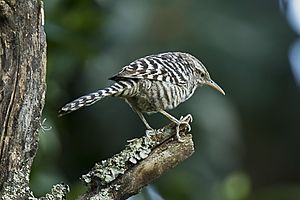Fasciated wren facts for kids
Quick facts for kids Fasciated wren |
|
|---|---|
 |
|
| Conservation status | |
| Scientific classification | |
| Genus: |
Campylorhynchus
|
| Species: |
fasciatus
|
 |
|
The fasciated wren (Campylorhynchus fasciatus) is a small bird that belongs to the Troglodytidae family, also known as the wren family. This interesting bird can be found living in the countries of Ecuador and Peru in South America.
Contents
Bird Families and Types
The fasciated wren belongs to the wren family. There are two slightly different kinds, called subspecies, of the fasciated wren. Their scientific names are Campylorhynchus fasciatus fasciatus and Campylorhynchus fasciatus pallescens. These subspecies have small differences in their appearance.
What Does the Fasciated Wren Look Like?
The fasciated wren is about 19 centimeters (7.5 inches) long. One female bird weighed around 25 grams (0.9 ounces). Both male and female fasciated wrens of the main type have a gray top of the head and grayish eyebrows. Their shoulders, back, and rump (the lower back) are dark gray.
You might notice whitish speckles on their shoulders and whitish stripes on their rump. Their tail has stripes of off-white and blackish-brown. The area under their chin is off-white with darker streaks. Their chest and belly are whitish with many dark gray spots. The sides of their body have dark gray stripes.
The other subspecies, Campylorhynchus fasciatus pallescens, looks a bit lighter in color. Its markings on the underside are not as clear. Young fasciated wrens also have less clear markings on their underside compared to the adults.
Where Do Fasciated Wrens Live?
The main type of fasciated wren, Campylorhynchus fasciatus fasciatus, lives along the coast of Peru. It can be found from the Department of Piura south to the Department of Lima. It also lives inland in Peru, from the departments of Cajamarca and Amazonas south to the Department of Huánuco.
The Campylorhynchus fasciatus pallescens subspecies is found in southwestern and southern Ecuador. It also lives in Peru's departments of Tumbes and Piura.
These wrens mainly live in dry and semi-dry areas. They like places with thorny bushes and shrubs. You can also find them in citrus orchards and other areas that people have changed a lot. In Ecuador, they sometimes live in more humid places like forests where trees lose their leaves. They usually live from sea level up to about 1,500 meters (4,900 feet) high. However, they can sometimes be found as high as 2,500 meters (8,200 feet).
Fasciated Wren Behavior and Habits
What Do Fasciated Wrens Eat?
The fasciated wren mostly eats small creatures without backbones, like insects. It also eats some plant material. These birds usually look for food in groups. They mostly search in bushes and shrubs, but sometimes they will look for food on the ground.
Fasciated Wren Reproduction and Nests
The fasciated wren's breeding season is usually from May to August in most areas. However, active nests have been seen in February and March in Ecuador. These birds are cooperative breeders. This means that groups of up to 10 birds, including a main breeding pair, help raise the young.
Their nest is shaped like a dome with an entrance on the side. They build it from grass and line it with feathers. They place their nests in different types of trees and cactus plants. They also often use old mud nests that were built by another bird called the pale-legged hornero (Furnarius leucopus).
How Fasciated Wrens Communicate
The fasciated wren often sings in a duet (two birds singing together) or as a group. Their song is a series of harsh, churring sounds mixed with gurgling notes [1]. Their call is a harsh "churr" sound [2].
Conservation Status of the Fasciated Wren
The IUCN (International Union for Conservation of Nature) has looked at the fasciated wren. They have decided that it is a species of "Least Concern." This means that the bird's population is stable and it is not currently at risk of disappearing. The fasciated wren seems to do well even in areas where humans have changed the habitat a lot, as long as there are enough bushes left for them.
See also
 In Spanish: Cucarachero ondeado para niños
In Spanish: Cucarachero ondeado para niños


